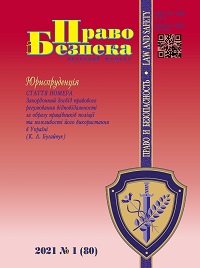Certain Aspects of the Analysis of Cryptocurrency Transactions during the Prevention and Investigation of Crimes
DOI:
https://doi.org/10.32631/pb.2021.1.13Keywords:
cryptocurrency, analysis of transactions, visualization, law enforcement agencies, crime preventionAbstract
The analysis of separate tools for the visualization of movement of cryptocurrency values, and also identification of users who carried out the corresponding transactions has been carried out. The advantages and disadvantages of cryptocurrency from the point of view of offenders and law enforcement agencies have been studied. The main directions of using cryptocurrency in a criminal environment have been determined. The current state and perspectives of normative and legal regulation of cryptocurrency in Ukraine have been analyzed. Theoretical principles of cryptocurrency functioning have been studied. The basic concepts used in this area have been revealed. The properties of cryptocurrency have been described. The mechanism of its issuance of guaranteeing pseudo-anonymity while working with cryptocurrency has been outlined. Some features of blockchain technology and formation of cryptocurrency addresses have been revealed. It has been noted that one of the first and most well-known cryptocurrency is bitcoin. The format of bitcoin address presentation has been described. It has been emphasized that bitcoin wallet software can operate with any number of addresses or each address can be served by a separate wallet. The technology of mixing transactions and the method of increasing the anonymity of CoinJoin have been described. The authors have revealed the possibilities of separate services intended for the analysis of cryptocurrency transactions (Maltego, Bitconeview, Bitiodine, OpReturnTool, Blockchain.info, Anyblockanalytics.com, Chainalysis, Elliptic, Ciphertrace, Blockchain Inspector). The process of risk assessment and construction of visual chains of cryptocurrency transactions has been demonstrated on the example of the “Crystal Expert” service. Different types of bitcoin addresses’ holders and risk levels have been described. The main and additional investigation tools used on the “Crystal Expert” platform have been revealed. Based on the conducted analysis, the authors have defined the main tasks for law enforcement agencies at the current stage of development of cryptocurrency. The basic requirements for tools designed for cryptocurrency analysis have been outlined. The authors have suggested some measures of law enforcement agencies’ respond to threats related to cryptocurrency.
Downloads
References
Kethineni S. and Cao Y., 2020. The Rise in Popularity of Cryptocurrency and Associated Criminal Activity. International Criminal Justice Review, Vol. 30, pp. 325-344. https://doi.org/10.1177/1057567719827051.
Nolasco Braaten C. and Vaughn M. S., 2019. Convenience Theory of Cryptocurrency Crime: A Content Analysis of U.S. Federal Court Decisions. Deviant Behavior. Available at: https://www.tandfonline.com/doi/full/10.1080/01639625.2019.1706706 [Accessed 13 December 2020].
Reddy E., 2020. Analysing the Investigation and Prosecution of Cryptocurrency Crime as Provided for by the South African Cybercrimes Bill. Statute Law Review, Vol. 41, Iss. 2, pp. 226-239. https://doi.org/10.1093/slr/hmz001.
Teichmann F.M.J. and Falker M.-C., 2020. Cryptocurrencies and financial crime: solutions from Liechtenstein. Journal of Money Laundering Control. Available at: https://www.emerald.com/insight/content/doi/10.1108/JMLC-05-2020-0060 [Accessed 13 December 2020].
Kethineni S., 2020. Cybercrime in India: Laws, Regulations, andEnforcement Mechanisms. In: Holt T., Bossler A. M. (eds.). The Palgrave Handbook of International Cybercrime and Cyberdeviance. Statesboro: Palgrave Macmillan. Pp. 305-326. https://doi.org/10.1007/978-3-319-78440-3.
Jiang J.K., 2020. Regulating Blockchain? A Retrospective Assessment of China’s Blockchain Policies and Regulations. Tsinghua China Law Review, Vol. 12, pp. 313-364. Available at: https://papers.ssrn.com/sol3/papers.cfm?abstract_id=3654439 [Accessed 13 December 2020].
Albrecht C., Duffin K. M., Hawkins S. and Morales Rocha V.M., 2019. The use of cryptocurrencies in the money laundering process. Journal of Money Laundering Control, Vol. 22, No. 2, pp. 210-216. https://doi.org/10.1108/JMLC-12-2017-0074.
Kuzuno H. and Karam C., 2017. Blockchain explorer: An analytical process and investigation environment for bitcoin. In: APWG Symposium on Electronic Crime Research (eCrime). Scottsdale, AZ, USA, 25-27 April 2017. Pp. 9-16. https://doi.org/10.1109/ECRIME.2017.7945049.
Balaskas A. and Franqueira V.N.L., 2018. Analytical Tools for Blockchain: Review, Taxonomy and Open Challenges. In: International Conference on Cyber Security and Protection of Digital Services (Cyber Security). Glasgow, UK, 11-12 June 2018. Pp. 1-8. https://doi.org/10.1109/CyberSecPODS.2018.8560672.
Cremona K., Tabone D. and De Raffaele C. Cremona, 2019. Cybersecurity and the Blockchain: Preventing the Insertion of Child Pornography Images. In: International Conference on Cyber-Enabled Distributed Computing and Knowledge Discovery (CyberC). Guilin, China (17-19 October 2019). Pp. 197-204. https://doi.org/10.1109/cyberc.2019.00042.



